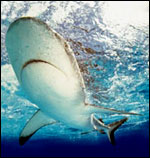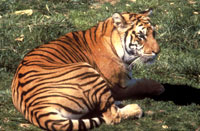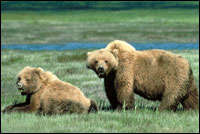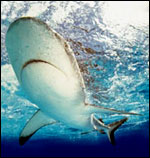
Monster of God
By David Quammen
W. W. Norton &
Company, 384 pages,
2003
What this world needs,” opined the nature writer David Quammen in a 1984 column for Outside magazine, “is a good vicious 60-foot-long Amazon snake.” He was kidding, thankfully; the rest of the column goes on to describe the human tendency to massively exaggerate the size of anacondas in the Amazon. Now, though, 19 years later, Quammen has written Monster of God, a book arguing that precisely what the world does need is very large, very predatory animals.
I do Quammen a disservice by calling him a nature writer. To the extent that he is one, it is only because he — along with the likes of Edward Abbey, Barry Lopez, and Terry Tempest Williams — has turned the genre upside down by allowing science, economics, politics, and culture to tromp all over its pastoral pages. By reinventing the content, these writers also reinvented the style: In Quammen’s work you will find no trace of the adjective-laden, sunset-stained daydreaming with which nature writing is, justly or unjustly, associated. Instead, you will find foul-mouthed Australians, baleful Siberians, frostbite, dictators, petty bureaucrats, history lessons, ethical impasses, crocodile blood on your glasses, and the occasional terrifying quadratic equation.
Crocodile blood notwithstanding, Monster of God does not belong to the genre Quammen characterizes as “predator porn.” Quite the contrary: In his last book, The Song of the Dodo, Quammen managed to turn the arcane field of island biogeography into a best-selling page-turner; in Monster of God, he reverses the trick, transforming stories of man-eating tigers and 20-foot crocodiles from tabloid perennials into a thoughtful exploration of the ecological and psychological roles of the beasts that eat us.

Lone shark.
Photo: NOAA.
A veritable ark of animals kill people — elephants, cobras, scorpions, spiders, malarial mosquitoes, the odd pit bull — but Quammen is not concerned with most of them in Monster of God. He’s interested strictly in those animals to whom we humans are meat, a group he denotes “alpha predators”: lions, tigers, bears, sharks, crocs, leopards, and a handful of others. All told, it’s a small group, and rapidly getting smaller. Exploding human population growth and related habitat loss are creating a vicious circle for vicious animals: With less territory to roam and fewer non-human prey available, alpha predators are increasingly likely to stray into populated areas, eat a person or two, incur the wrath of the locals, and be hunted in response — sometimes to local extinction. As Quammen observes, “man-eating is the most fatal of indiscretions, in that it often provokes retaliatory eradication.”
As a result, Quammen envisions a not-very-distant future — 2150, to be precise, although precision is a famously dicey hobby for prophets — in which the last viable wild populations of human predators will be extinct. The bulk of Monster of God is dedicated to explaining why, using case studies of four predators: the lions of the Gir forest in western India, the crocodiles of northern Australia, the grizzly bears of Romania, and the Siberian tigers of you know where. Quammen also looks at those predators that can’t be found on the Red List but stalk the forests of the imagination: Grendl (the bad guy in Beowulf), Humbaba (the nemesis of Gilgamesh), the biblical Leviathan, and, most oddly, Ridley Scott’s Alien.
Fearful Asymmetry
In literature and myth, monsters prey on the vainglorious, the impious, or the foolhardy; when all is said and done, there’s generally a moral written in the blood. In real life, predators prey on whatever — or whomever — is nearby, with brutal amorality. As it happens, those who are nearby are typically poor rural dwellers lacking either the material or political resources to protect themselves from predation. Thus, as Quammen notes, the hardships of living with alpha predators are borne largely by the world’s poorest and most disenfranchised people, while it is the wealthy who enjoy the lion’s share (so to speak) of the spiritual and aesthetic benefits of such animals. Not coincidentally, it is also the wealthy who most ardently advocate preservation.

When the cat’s away …
Photo: USFWS.
This unequal relationship to alpha predators is frequently overlooked by impassioned conservationists in the developed world. But Quammen never lets it recede too far into the background, thereby preventing the book from straying near sentimentality or self-righteousness. He asks: Can we have alpha predators if we’re unwilling to suffer and die because of them? And then: “Whom do we mean by ‘we’?” If the answer to the first question is to be “yes,” he says, the costs and benefits of alpha predators must be more evenly distributed.
To date, the only truly viable way to effect that redistribution is to offer financial incentives to locals to help conserve endangered species. Generally speaking, that means making a commodity of some small percentage of the animals — inviting foreigners to pay top dollar for the right to hunt bears in Romania, say, or creating a controlled global market for legally obtained crocodile skins or tiger pelts. If local people are involved in these transactions and receive a percentage of the profits, the logic goes, their livelihoods will depend on the continued existence of the animals and they will become highly motivated preservationists.
As Quammen shows, that theory is borne out in case after case, from Australia to Siberia. Yet however effective such programs may be, they generally receive a chilly reception from environmentalists, due to “popular resistance, based on principle or emotion, to the idea of killing so much as one tiger, one lion, one bear for someone’s profit.” Even Quammen, who is so wary of dogma that one suspects he fails his knee-jerk test at the doctor’s office, can’t help but balk at this Babbittry: “No matter how often I hear [this commodities argument] applied to one or another magnificent species in their various corners of the world, each time I find it tedious afresh. But, beyond quibbling over details … I can’t rationally disagree.”

A grizzly situation.
Photo: USFWS.
As both the cost-benefit conundrum and the commodities solution demonstrate, the logic of large-animal preservation does not cleave to moral law as closely as one might like. At times, indeed, it’s enough to make even the most philosophical of environmentalists squeamish. Perhaps nowhere is this more clearly illustrated in Monster of God than in its brief history of Nicolae Ceausescu, under whose brutal dictatorship Romanians suffered appalling human rights abuses — and grizzly bears flourished. Quammen notes “a peculiar correlation between ursine abundance and autocratic oppression: positive.” More paradoxical still, Romania’s grizzlies flourished precisely because Ceausescu was a bloodthirsty hunter, single-handedly slaughtering some 400 bears during his reign — and thereby creating a very good incentive for forest managers (who were responsible for guaranteeing the dictator a successful hunt) to make sure bear populations thrived.
But not all political enterprises that have been devastating for humans have been kind to alpha predators. In Monster of God, Quammen offers a theory (“really only a notion”) that colonialism and the decimation of predators go hand in hand. Motivated by “detachment and ignorance and fear,” colonial powers destroy native predators to assert “their sense of cultural superiority, seize hold of an already occupied landscape, and presume to make it their own.” That hypothesis, he says, goes some way toward explaining the ongoing hatred many Westerners feel for the grizzly bear: “[A] war of territorial seizure that began with Lewis and Clark … won’t be over, not quite, until the last individuals of the animal … have been eradicated from the northern Rockies and the forests (on public land as well as private) are safe for white people and their cows.”
It’s Lonely at the Top of the Food Chain
These kind of side trips — to Ceausescu’s Romania, to the white Westerner’s id — are among the best things about Monster of God. In this book, as in Song of the Dodo, Quammen’s M.O. is the anecdote; he excels at finding the telling story, and at telling it. Who else would illustrate the relationship between market demand and endangered species conservation by introducing a taxidermist in the Australian outback who earns his living by preserving crocodiles for the local chapter of the Hell’s Angels? Trust me, you do not want to miss Quammen’s four-and-a-half page deadpan account of memorizing the recipe for pickled crocodile head.
In Song of the Dodo, Quammen used such anecdotes to breathtaking effect. Each tale on its own was gripping; pieced together, they eventually yielded a stunningly clear big picture, a sobering depiction of the workings of biogeography and its implications for our modern, crowded, all-too-human planet. I waited in vain for the same gratifying illumination in his new book, the a-ha! that punctuates the reading of a convincing and carefully wrought work. But Monster of God is more slideshow than jigsaw puzzle; each individual picture is lovely, but the effect is of repetition, rather than accumulation.

Lion in wait.
Photo: USFWS.
I suspect that this problem has more to do with the subject than the author. With his prodigious intellect, Quammen was right at home explaining some of the more obscure aspects of evolutionary theory. Monster of God doesn’t grapple with anything quite so dense. Habitat loss, the disappearance of prey, conflict with humans — these are the major factors that threaten alpha predators, and, as Quammen himself acknowledges, their inexorable interplay is obvious to even the most casual dabbler in ecology. As a result, there’s simply nowhere for him to go once he’s gotten started; one suspects that he needed, well, meatier material.
The potential impact on the human psyche of the wholesale disappearance of alpha predators should have provided just that kind of rich fodder, and Quammen makes a go at it with his forays into literature, myth, and moviemaking. It’s greatly to his credit that he can converse intelligently about ecology in one moment and about third century Babylonian literature the next (he frets that studying Gilgamesh, with all its translation and fragmentation issues, is like having “an important conversation on a cell phone while driving the freeway”), yet here, too, he comes up short. These forays are like blind alleys in a maze; they’re fun to explore, but they don’t lead anywhere and they don’t connect to one another.
That’s a pity, because there are truly important questions to be asked here. Once we human beings have ascended to the top of the food chain by lopping off its upper reaches, what will happen? Will some collective atavistic fear of ours be put to rest forever? Will we feel liberated? If so, what will that sense of liberation mean for the rather tattered notion that humanity is embedded in rather than above the natural world? And if that notion follows lions and tigers and crocs to extinction, what will that mean for efforts to protect the environment?
On the other hand, what if, instead of feeling liberated, we feel somehow bereft when alpha predators are gone? Quammen suggests that will be the case, and points to our appetite for movies like Alien as evidence that we yearn to be reminded of our fundamental edibleness. That’s interesting, but it’s hardly a strong case for the protection of species on this planet. Granted, arguments for the protection of species based on their psychological importance to humans are risky anyway, since they inherently promote the protection of charismatic megafauna at the expense of obscure (or noisome, or icky) microfauna. Still, I wish Quammen had done more to convey the sense of loss we may feel if we extinguish all our predators — and thus made the need to protect them more compelling.
Yet even with Monster of God’s shortcomings, I finished it asking myself the same questions I ask virtually every time I read anything by Quammen: How does anyone land such an impossibly fantastic job? And: When is his next book coming out? Even when he fails to live up to the rather high bar of class-A nouveau nature writing he helped set, Quammen makes for such an able and entertaining wilderness guide that you’re happy simply to be along for the ride. The vicarious thrill of skiing in Siberia or going nose-to-snout with crocodiles in Australia never pales, and nor does the delight of learning (sometimes in passing) things you never even thought to wonder about.
Nor, finally, does the sheer pleasure of his language. If Monster of God lacks the a-ha! of insight, it doesn’t want for the straight-up ha! of literary dazzle. This is a writer who pauses to note that important people get lionized, not tigerized; who characterizes Darwin, Australia, as “the capital of croc schlock”; and who describes the colors of homes in a Siberian village thusly: “What once may have been chartreuse now looks more like wasabi. Some sort of vivid cerulean has faded to cheery but flat shades of blue, the hue of wilting party balloons and elderly parakeets.” Wasabi? I’m glad ecology got him before J. Crew could. Given the dire state of the global environment, we’re lucky to have a voice in the wilderness this erudite, and this fun.

